What are the Main Instruments in Folk Music?
by Dave Fox
There are some traditional instruments used in the making of folk music. Whether you want to make some folk music on your own, or you are curious about the instruments used in folk music, this guide should help.
We cover many of the instruments used in folk music from the traditional like the banjo and guitar to the non-traditional like the jug or spoons.
Contents
The Main Instruments in Folk Music?
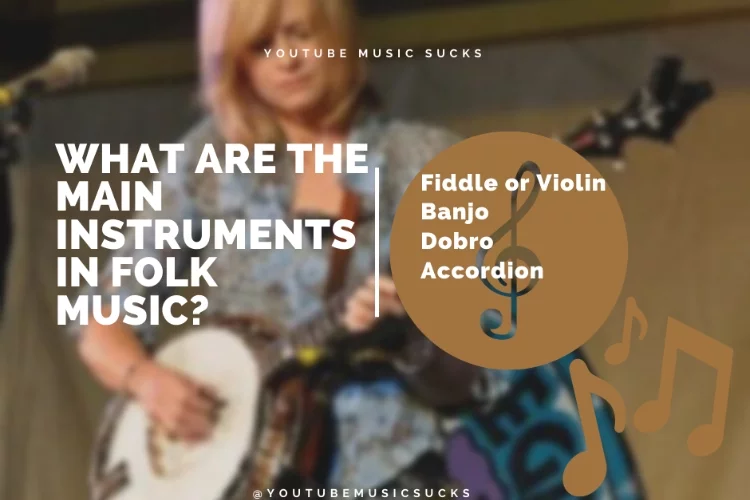
Fiddle or Violin
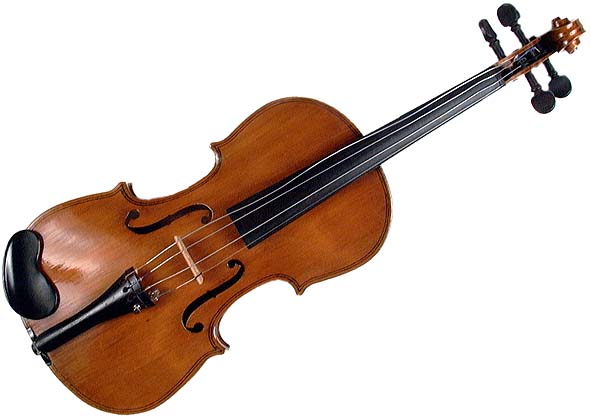
What is a Fiddle?
A fiddle is any bowed string instrument that has four strings and a fingerboard. Many folk music traditions have different names for various types of fiddles, although the word itself refers to whatever type of instrument is being discussed. In America, we call all stringed instruments with fingerboards fiddles.
What is a Violin?
The violin is the most common type of fiddle. It comes in different sizes to suit players of different ages, but because there are no distinct differences between violins and fiddles (besides size), many people call all instruments with fingerboards fiddles when discussing folk music.
When the violin is being played for folk music, it's called a fiddle. In both cases, it's a 4- or 5-string instrument that is played in a certain way. While violinists are playing classical music in a style that demands perfection and accuracy for every note, fiddlers are able to give their own interpretation of music in a way that moves them.
What is a Viola?
The viola is the second smallest fiddle, and it has about one octave less range than the violin. In the orchestra, you will see violas used in string ensembles because they can blend their tone with other instruments while still being able to stand out at certain points. You can also see them used in folk music, although the violin is more common.
What is a Cello?
The cello is the largest fiddle, with about one octave less range than the viola. It was originally called the 'viola da braccio' and it was developed as a bass instrument for orchestras. It's still used in orchestras today, but you can also see cellos used for folk music - especially because of their deep tone - although the violin is more common.
A fiddle and violin is actually the same instrument played in varying styles.
Banjo
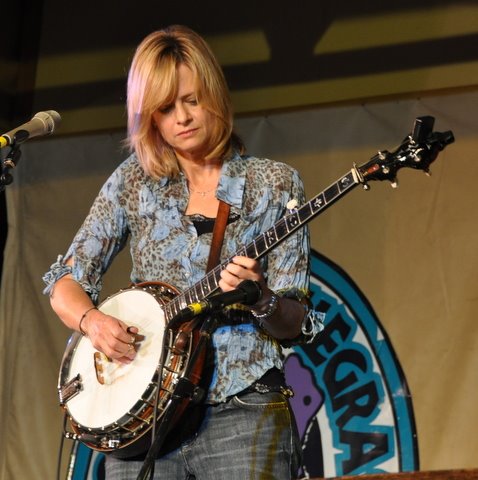
A banjo is a stringed instrument that looks like a small guitar. It has four or five strings and an open back, but otherwise it is similar to the classic guitar (classical guitar) in its structure and tuning modes. Most people play the banjo by sitting down and using a five-finger style of picking notes with their right hand fingers. The banjo has historically been used to play classical music, but it is often used in folk (traditional) music of many different styles around the world.
What makes the banjo special for folk music is that it can be adapted to almost any musical genre using a variety of techniques and styles. This adaptability is partly due to the banjo's versatility as a stringed instrument for folk music. It is small enough to play with an average guitar player, but still produces a rich sound by itself.
The Banjo Is a Versatile Stringed Instrument for Folk Music
Banjos are built of either wood or metal. The neck of a wooden-necked banjo usually has 14 frets, and it can have a double- or triple-strung scale length. The metal neck of a silver-necked banjo may have as few as 12 frets, but most professional models have at least 21 frets. Silver-necks are generally the preferred choice for bluegrass music. The head of both types of banjos can be tensioned with a machine screw that tightens or loosens the whole neck.
The banjo is strung with four to six strings, but only four are usually played for folk music. Each string has its own tuning peg at the top of the neck where it attaches to the head. The strings on a standard banjo are usually tuned to G, D, B, and high G. In folk music the high G is often omitted from the full scale because it is hard for many players to reach that note with one hand.
Summary of Banjo for Folk Music
The banjo is one instrument that people think of when they are wondering how to make folk music. They come in different styles from the 5- or 6-string variety.
They're played in styles like the clawhammer or Scruggs They're a distinctive twang sound that most people associate with folk music.
Dobro
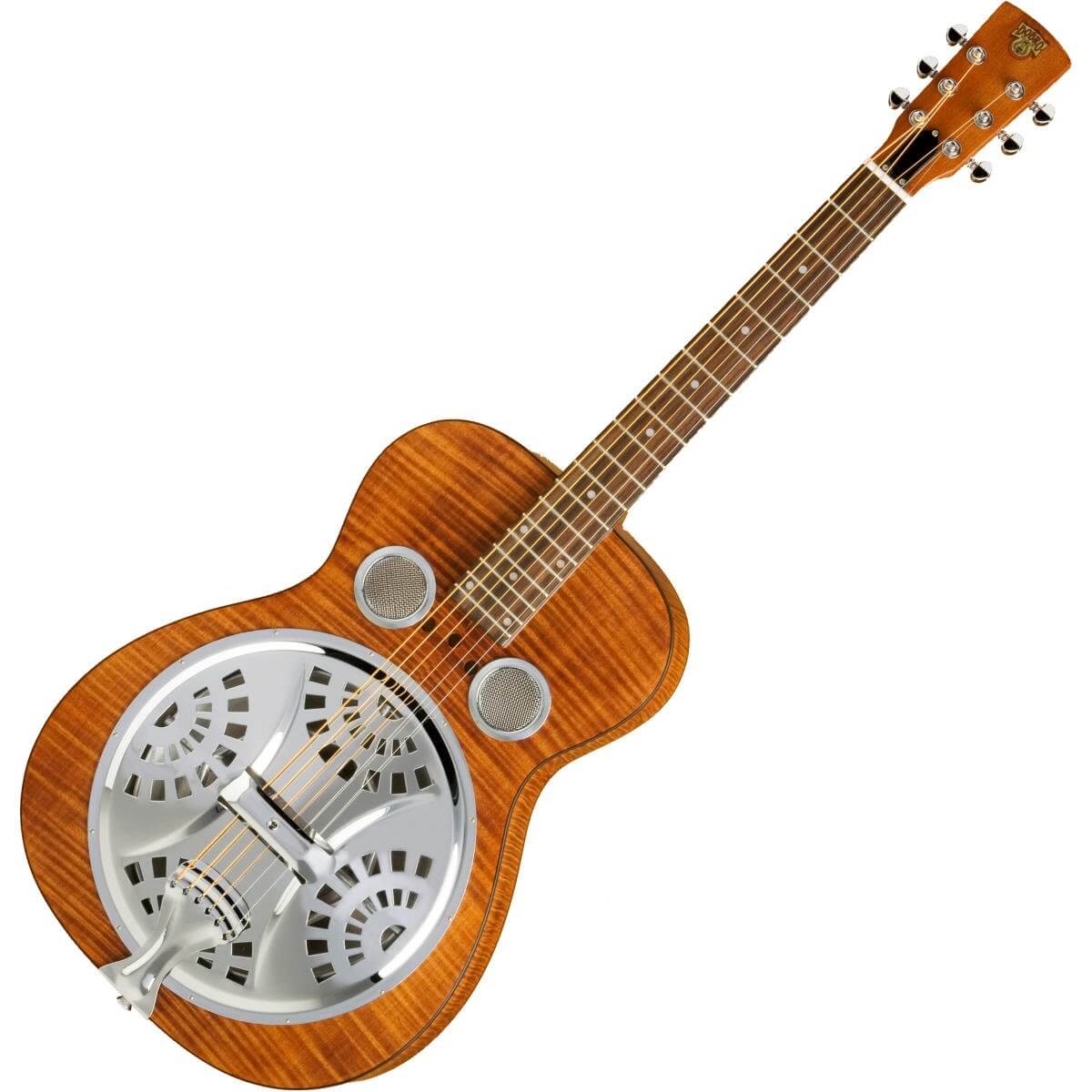
The Dobro is an American brand of guitar and a resonator steel- string instrument with a single inverted- cone resonator as its distinctive feature. It was developed in the early 1930s by noted manufacturer John Dopyera, who sought to design an instrument that could produce greater volume than archtop guitars while retaining their acoustic qualities; unlike most other resonator guitars, the Dobro has a wood body. The name "Dobro" means "good voice" in Croatian (which is pronounced [dôbro]), language of one of Yugoslavias' Slavic ethnic groups.
The original design of this instrument is thought to date back to 1927 when John Dopyera returned to the United States after having been employed at the Dopyera Brothers musical instrument company with his brothers Rudy, Emile and Louis Dopyera, a company which they had co-founded in southern California. Working on his own, he developed a single resonator model by early 1931 that essentially embodied all of the features of the Dobro as it would evolve.
The Dobro All-Electric featured a simple one-pickup design, with the only other control being a volume knob mounted on a square plate on the lower treble bout of oval sound hole (with round sounding holes). The Dobro Electric had more features than the model D including metallic body binding and a metal tailpiece.
The Dopyera brothers, along with a friend John R.y. Bray and factory superintendent William Bartholemew, patented the first resonator guitar design on May 2, 1927. The patent states that it was to go into production as the "Bass-Reflex" model but after several years of prototype development, including the introduction of electric amplification, the design was perfected to its present form. The patent for the Dobro resonator remained in force longer than any other product-line associated with the company. This is an interesting fact considering that no great amount of original research has gone into this rather simple looking instrument, which actually helped it remain economically sound through mass production.
Summary of Dobro for Folk Music
This instrument is a type of guitar with a resonator attached to the front. It's an inverted surface that produces a unique sound for the Dobro.
While the name and the type of guitar with resonator was developed by the Dopyera brothers, it's now owned by Gibson Guitar Corporation.
They make all the current Dobros and have a trademark on the process and name. This guitar produces a unique sound that is well-known for folk music lovers. It's a common instrument in bluegrass, too.
Accordion
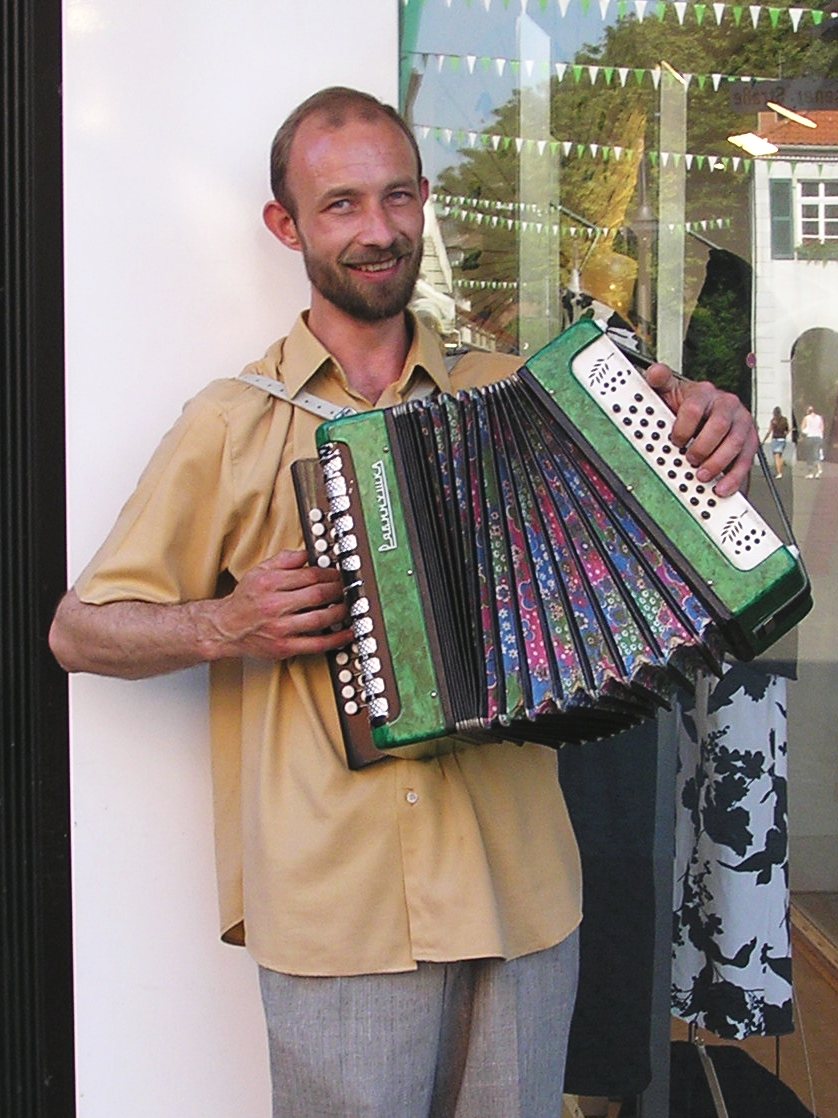
During the 20th century accordion spread abroad and replaced traditional instruments at home. It was not only used for "easy dance music" but also during the revolutions in 1848 and in 1871 (Germany). Beside its use in popular music it has been very dominant in polka, folk and country. The accordion can be considered as a typical immigrant instrument due to its wide spread among European immigrants who took it with them to the New World.
It was welcomed in countries where it had never been used before.
The European accordion was introduced to China during the Qing-dynasty (1644-1911) by Catholic missionaries who wanted to spread their faith. The instrument became very popular, especially among the Hakkas and Hoklos in South China. The introduction in the West is usually attributed to the Italian musician Guido Dufgens in 1855. He had learned about it during his stay in Beijing in 1850 where he performed on the Chinese instrument.
The instrument was further developed into an advanced chromatic button accordion by Cyrill Demian around 1860, which became very popular in Austria-Hungary with over half a million manufactured annually.
The instrument was embraced by nearly all social classes and has been an integral part of European music culture ever since. It belongs to the most successful and popular instruments in Europe and North America, as can be seen by its presence in films like "Good Bye Lenin" (2003), where it is used during the famous demonstration when the Berlin Wall was taken down.
Summary of Accordion for Folk Music
While mostly associated with polka music, it's part of Cajun and folk music. The instrument is versatile, and it can be used in all kinds of music with folk topping the list.
There are piano keys on one side buttons on the other. In the middle is the bellows, which is opened and closed to produce the sounds.
Harmonica
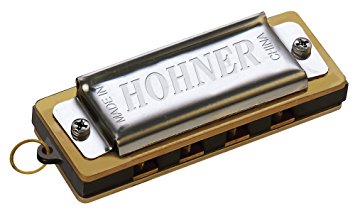
The harmonica has been used in folk music for a very long time. In the past, it was especially common for blues and folk musicians to play and sing while accompanied by a harmonica player. There's just something about that old-time sound that screams "pick up an instrument and join in on the fun!" Before we go over some basic folk songs to play on the harmonica, let's first take a look at how you can start learning more complex pieces on an instrument like this. The first and most important piece of advice is: slow down! There's no need to be a speed demon a mile off. You'll be able to play faster in time, but there's no need to rush things from the get-go! It's better to take it slow and get everything right from the start.
Also, make sure that you're breathing properly while playing the harmonica. In order to keep going for extended periods of time, you'll have to breathe in well before your lungs are completely empty. You might not be able to keep that up for the full length of a song, but you should definitely aim to get as much air into your lungs before an inhale as possible.
A good way of practicing breathing is by singing through the harmonica. It's one thing to sing with it, but you should also be able to cover the entire range of your voice by singing through your harmonica. It might sound silly at first, especially if you're not used to singing in that manner, but there's actually a purpose behind it! When you inhale with the harmonica still in your mouth, you're getting practice at being able to fill your lungs with air.
After you feel confident in your breathing ability, start working on a song that's a bit more complex. Familiarize yourself with it and try playing through it once without making any mistakes. Take breaks when you need to! Getting all frustrated and worn out won't help you learn any better.
Once you feel like you can play the song reasonably well, start adding in mistakes and variations on your own. You might not be able to come up with any right away, but it's a good exercise nonetheless. A mistake doesn't have to be anything major - just something that makes the song sound less perfect. Maybe you accidentally repeat a note or miss out on playing one entirely. As long as it's noticeable, you're good!
Summary of Harmonica for Folk Music
The "mouth harp" is a portable instrument that is used in many folk music songs. It's made of wood or plastic and metal. The reeds inside the instrument vibrate when the musician blows into it or sucks air out of it.
Both produce sounds that differ depending on the holes used. There are 10 numbered holes on the side of the harmonica.
Non-Traditional Instruments
There are a few non-traditional instruments that can be used for folk music like the musical jug.
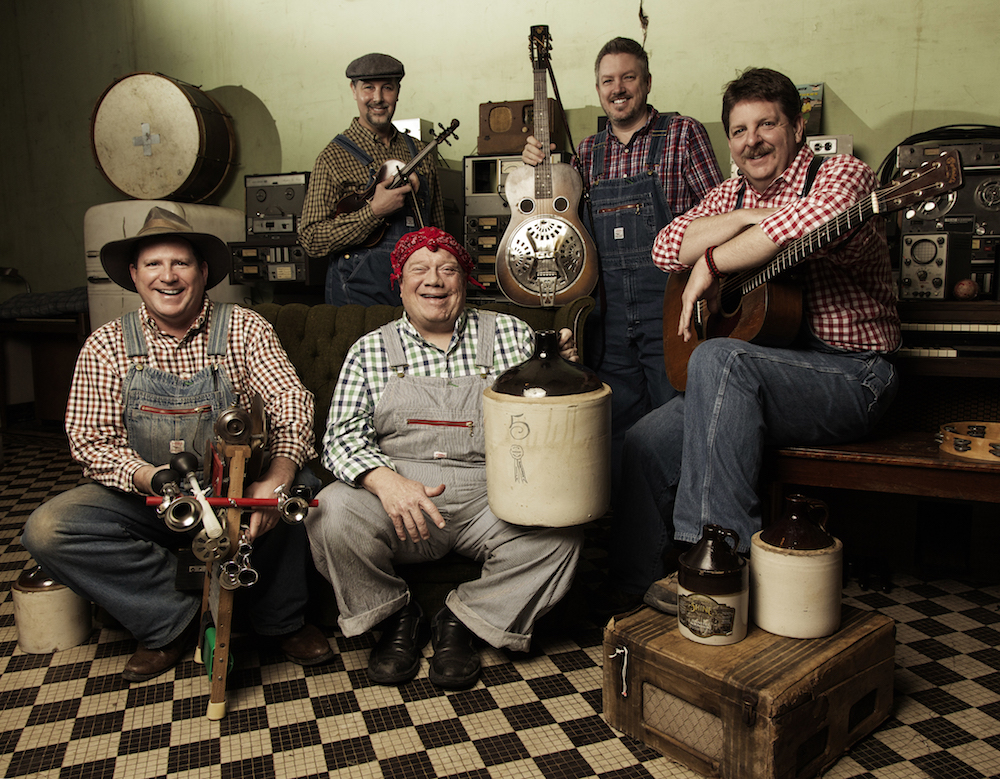
The jug is made of stoneware, glass, or ceramic, and the musician blows into the top of it to produce a mournful sound that functions as the bass in most songs.
The spoons are another non-traditional instrument used in traditional folk music. Wooden or metal spoons are placed back to back and slapped between the musician's hands or against their leg. There are musical spoons available or regular spoons can be used.
Acoustic Guitar
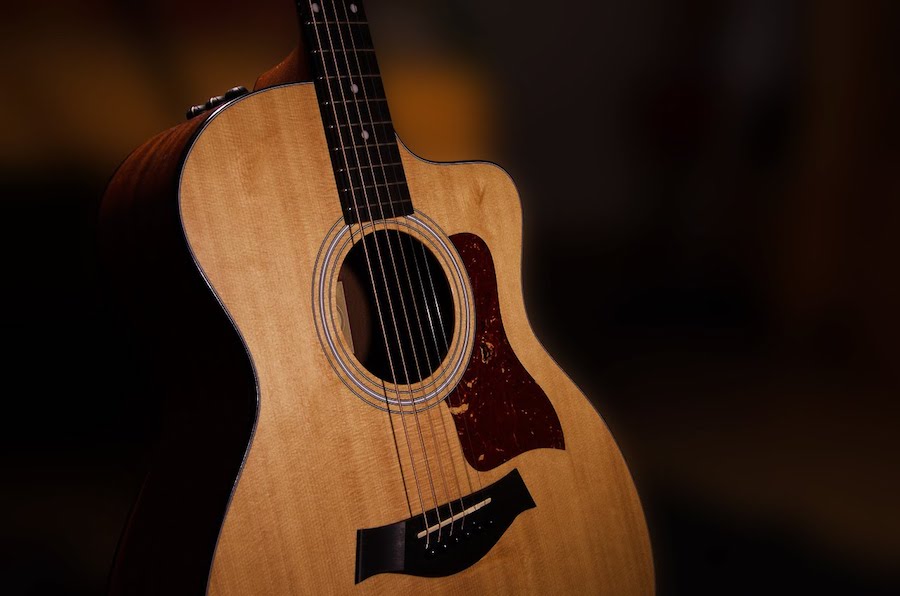
The biggest instrument in folk music is the acoustic guitar. It's the most traditional and prevalent instrument in the genre.
Many of the greatest folk musicians worked exclusively with an acoustic guitar to create their iconic music. Gibson, Fender, and Gretsch are some of the popular models used by famous folk musicians.
Mandolin
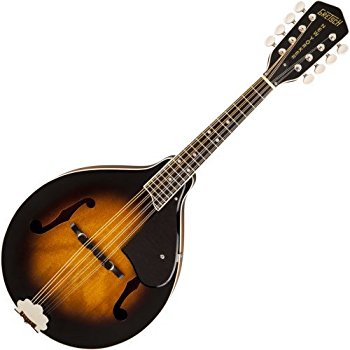
The mandolin looks like a tiny guitar. It has a distinct sound that lends itself to bluegrass and folk music quite beautifully.
It's considered a part of the lute family, which shouldn't be a surprise since it looks like a guitar. It normally has 8 strings that are tuned at the same time. It became popular in the south in the 40s along with the banjo and guitar.
Ukulele
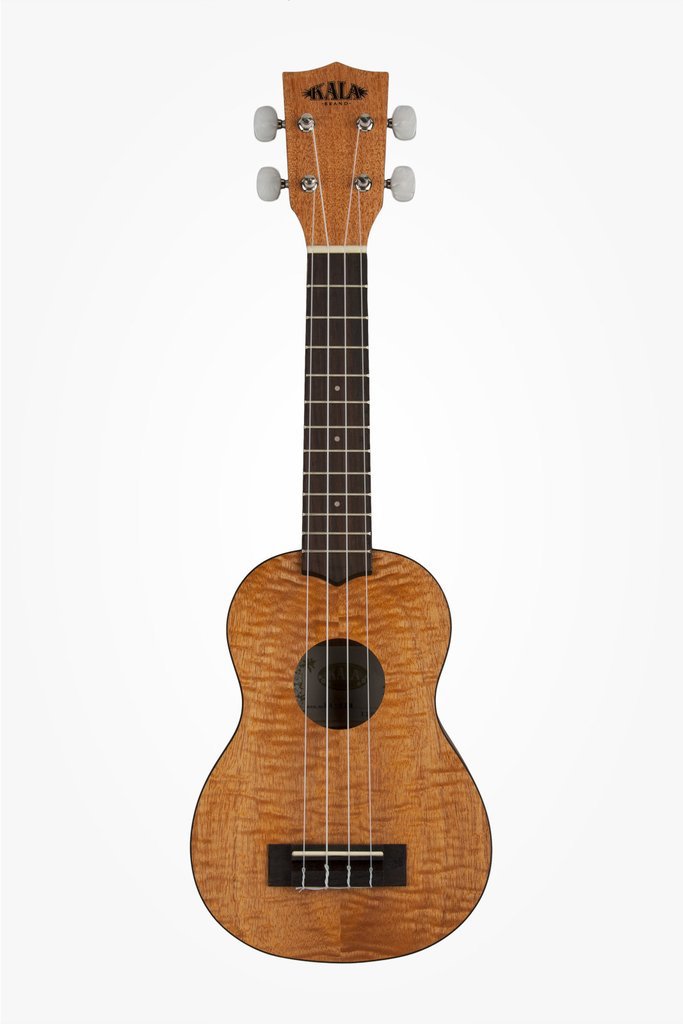
This is another instrument in the lute family. The banjo, guitar, ukulele, and mandolin all lend themselves to the genre of folk music.
The preferred wood for the ukulele is the acacia koa, which makes sense since the instrument originated in Hawaii. It looks like a miniature acoustic guitar with four courses of strings for 8 total.
The size of the ukulele dictates the type of sound it produces. There are 4 sizes, which are the baritone, tenor, concert, and soprano.
This could be a curiosity in your life, or you might be thinking of making folk music solo or in a band. Whatever your reasons for checking out folk instruments, these are some of the most popular in this form of music.
At the same time, the intent behind the instrument can be more powerful than the instrument itself for making the kind of music that you want. If you want to make folk music on an instrument not listed here, you should go for it.
You are only limited by your ability and imagination when it comes to instruments in folk music.
Enjoy Folk Music Instruments
Once you get into playing folk music on your instrument, or when you start to learn an instrument in the hopes of playing folk, you will inevitably run across frequent use of certain terms. If you're like me when I first started learning about these instruments and styles, chances are good that many of the terms and vocabulary concepts mentioned in online discussions and in books are going to fly well over your head, leaving you with a lot of questions and no way to get answers. Folk music refers generally to any music which is traditional in style, meaning that it has been passed down by oral or practical tradition, and not via academic training. Traditionally, folk songs have one or more of the following characteristics:
- They are not written down.
- They are passed along by word of mouth.
- They use nonstandard musical notation (i.e., neither standard staff notation nor tablature).
- The song is based on a single chord progression or mode, which is never changed.
- They are simple melodies that are easy to remember, making them easier to pass along by word of mouth.
There are many genres of folk music, including French Canadian, Irish, English, American (e.g., Appalachian), Cajun, Hawaiian, Icelandic, Finnish, Swedish, Norwegian, Russian, Ukrainian, Greek (especially Crete), Serbian (Lebanon), Romani (also known as "Gypsy" music), and Bulgarian.
Folk instruments are any musical instruments which are used in folk music; that is to say they're traditional rather than modern in style. Folk instruments are also traditional in the sense that they are not usually taught in conservatories or universities, but rather are learned by way of private lessons or apprenticeship. The following definition is taken from Wikipedia:
A folk instrument is a musical instrument that developed among common people and usually does not have a known inventor. It can be made from wood, metal or other material. Many folk instruments are used in folk music.
Conclusion
The main instruments in folk music are typically acoustic guitars, banjos, fiddles, mandolins and accordions. Folk music usually has simple melodies that can be played with just a few chords on the guitar. These songs often tell stories about love or relationships gone wrong. Folk is also known for its upbeat tempos and lively rhythms which make it perfect to dance along to at your next party!
 |
 |
 |
 |

About Dave Fox
Recorder of many songs, haver of many albums. Dave (AKA Young Coconut) has been making music for the past twenty years or so, of varying genres and degrees of quality, to the dismay of listeners and algorithms everywhere. He’s also in the Suburban Bicycle Gang with Jerry Grey.
Dave has a keen interest in studying all aspects of music history, especially experimental / genres like jazz, krautrock, drum n’ bass, and no wave.
Here’s his Spotify: https://open.spotify.com/artist/1v3iPVEXzurahTI2Tm4Tpm
Leave a Reply
Check for FREE Gifts. Or latest free acoustic guitars from our shop.
Remove Ad block to reveal all the rewards. Once done, hit a button below
 |
 |
 |
 |